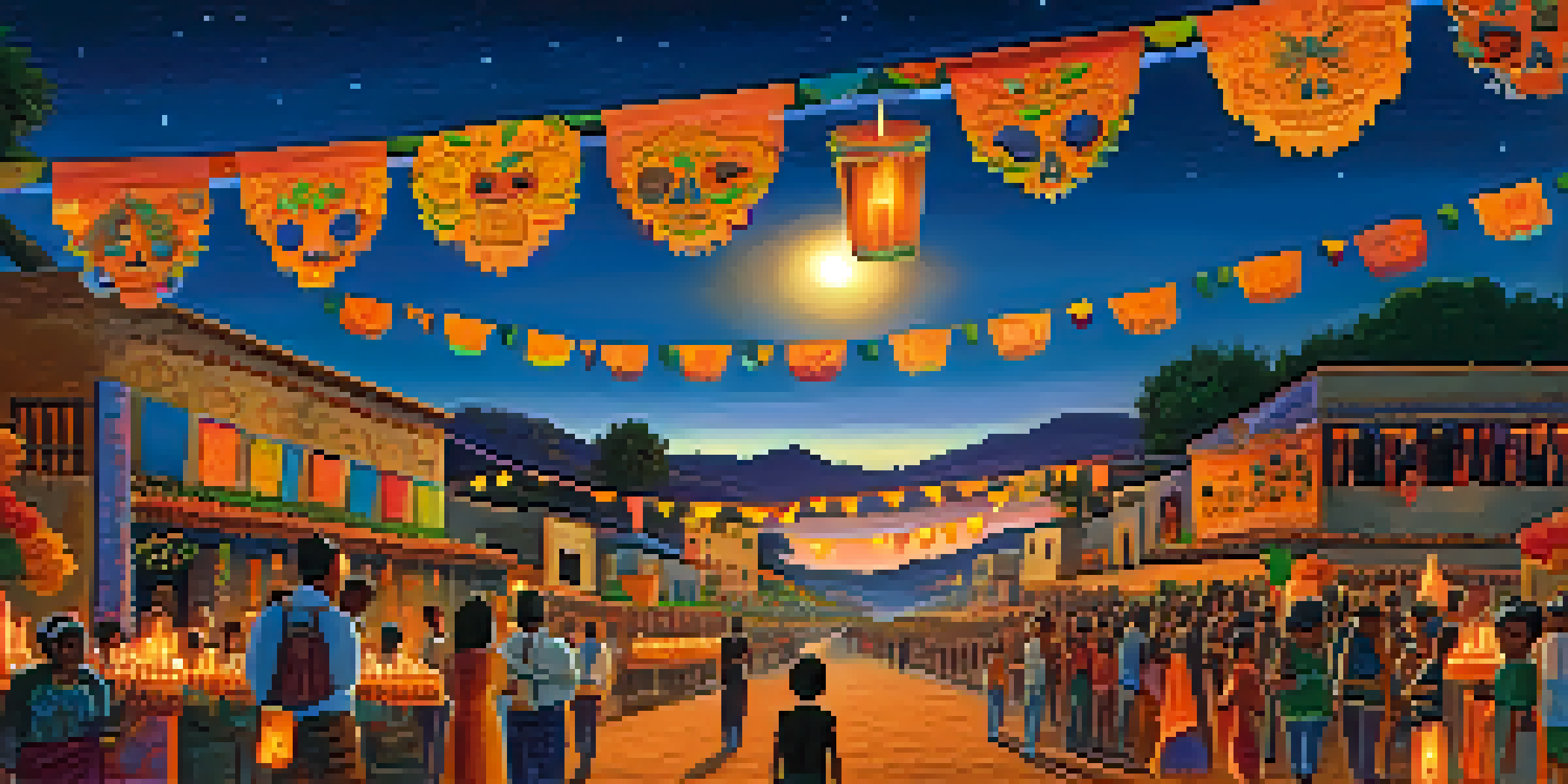Cultural Representation in Hollywood Adaptations of Books

Understanding Cultural Representation in Film Adaptations
Cultural representation in film, especially adaptations of books, is about how different cultures are portrayed and perceived on screen. It shapes audience understanding and can influence societal attitudes. When a beloved book is adapted into a movie, the way cultural elements are depicted can either enhance or detract from the original narrative.
Film is a powerful medium for cultural representation, and it can either reinforce stereotypes or challenge them.
For instance, consider how the film adaptation of 'The Joy Luck Club' brought to life the complexities of Chinese-American experiences. The movie not only showcased rich cultural nuances but also addressed themes of generational conflict. Such representations can foster empathy and encourage dialogue among diverse audiences.
However, when cultural elements are misrepresented or oversimplified, it can lead to stereotypes. This can be damaging, as it reinforces misconceptions rather than promoting understanding. Ultimately, filmmakers have a responsibility to honor the source material while accurately representing the cultures involved.
The Impact of Cultural Misrepresentation
Cultural misrepresentation can result in negative stereotypes that perpetuate harmful beliefs. When filmmakers take creative liberties without understanding the culture they are portraying, it can lead to narratives that are not only inaccurate but also damaging. For example, the adaptation of 'The Last Airbender' faced significant backlash for its casting choices and portrayal of Asian cultures, which many felt were diluted or misrepresented.

Such missteps can alienate audiences and diminish the potential of a story to resonate with those it seeks to represent. The disappointment felt by fans of the original material can also overshadow the film’s achievements. This highlights the need for sensitivity and authenticity in the adaptation process.
Cultural Representation Matters
Accurate cultural representation in film adaptations can enhance understanding and foster empathy among diverse audiences.
Moreover, misrepresentation can lead to broader societal implications, reinforcing prejudices and hindering cultural appreciation. As audiences become more aware and vocal about these issues, filmmakers are increasingly called to account for their choices. This evolving landscape suggests a push for more thoughtful and accurate portrayals in future adaptations.
Successful Examples of Cultural Representation
On the flip side, there are notable examples where Hollywood adaptations have successfully represented diverse cultures. Take 'Coco,' for instance, which draws heavily from Mexican traditions and the celebration of Día de los Muertos. The film's vibrant visuals and authentic music resonate deeply with audiences, showcasing the importance of honoring one’s heritage.
Diversity in film is not just a trend; it's essential for a more accurate portrayal of our world.
Another successful adaptation is 'Crazy Rich Asians,' which not only provided a platform for Asian actors but also explored themes of family, love, and cultural identity. The film was praised for its genuine representation, and it sparked conversations about the importance of diversity in Hollywood. Such examples show how thoughtful adaptations can uplift and celebrate culture.
These successes serve as a reminder that when filmmakers approach cultural narratives with respect and authenticity, the results can be powerful. They not only entertain but also educate, bridging gaps between different communities. The positive reception of these films indicates a growing appetite for genuine cultural representation in mainstream media.
The Role of Authentic Voices in Adaptations
Authentic voices play a crucial role in ensuring accurate cultural representation in film adaptations. Involving writers, directors, and actors from the culture being depicted can lead to a more nuanced and respectful portrayal. For instance, the adaptation of 'The Hate U Give' was enriched by the involvement of those who understood the complexities of race and community in America.
When creators draw from their lived experiences, it adds depth and authenticity to the storytelling. This approach not only honors the source material but also resonates more profoundly with audiences who identify with the cultural elements being portrayed. Authentic voices help to challenge stereotypes and provide a fuller picture of the culture.
Misrepresentation Creates Stereotypes
Cultural misrepresentation risks perpetuating harmful stereotypes, alienating audiences and overshadowing the film's narrative.
Moreover, by supporting diverse talent in the industry, Hollywood can foster a more inclusive environment. This shift encourages more stories to be told from different perspectives, leading to richer narratives. Ultimately, the inclusion of authentic voices is a step toward a more equitable representation in film adaptations.
The Influence of Audience Expectations on Adaptations
Audience expectations significantly shape how filmmakers approach adaptations. Fans of the original books often have strong opinions about how their beloved characters and cultures should be portrayed. These expectations can pressure filmmakers to adhere closely to the source material, sometimes at the expense of creativity.
For example, adaptations like 'Harry Potter' have faced scrutiny for how various characters were depicted, particularly in terms of race and culture. Fans often argue for more inclusive casting and representation, reflecting a growing awareness about diversity. Filmmakers must navigate these expectations while trying to create an engaging cinematic experience.
Striking a balance between honoring the original work and meeting audience expectations can be challenging. However, when filmmakers listen to feedback and incorporate diverse perspectives, they can create adaptations that resonate with a wider audience. This dialogue between creators and consumers is essential for fostering a more inclusive cinematic landscape.
Challenges of Adapting Diverse Narratives
Adapting diverse narratives comes with its own set of challenges. One significant hurdle is the risk of oversimplification, where complex cultural stories are condensed into a two-hour film. This can result in a loss of depth and richness, leaving audiences with only a surface-level understanding of the culture being portrayed.
Moreover, the commercial interests of Hollywood often prioritize box office potential over authentic storytelling. This can lead to adaptations that cater to mainstream audiences rather than remaining true to the original narrative. When the focus shifts to profitability, the integrity of the cultural representation can suffer.
Authentic Voices Drive Accuracy
Involving creators from the depicted culture leads to more nuanced and respectful portrayals in film adaptations.
These challenges highlight the importance of collaborative efforts between filmmakers and cultural consultants. By working together, they can ensure that adaptations are both engaging and respectful. While the road to successful cultural representation in adaptations is fraught with obstacles, it is a journey worth undertaking for the sake of storytelling.
The Future of Cultural Representation in Hollywood
The future of cultural representation in Hollywood adaptations appears to be shifting toward greater inclusivity. With audiences demanding more authentic narratives, filmmakers are becoming increasingly aware of the importance of cultural sensitivity. This evolution suggests a potential for more diverse stories to be told on the big screen.
Recent trends show a rise in films that embrace multicultural narratives, such as 'Black Panther' and 'Minari.' These films have not only achieved commercial success but have also sparked discussions about representation in the industry. As more voices are heard, there is hope for a broader spectrum of stories to emerge, reflecting the diversity of the audience.

While challenges remain, the push for change indicates a promising future for cultural representation in Hollywood. As filmmakers continue to learn from past missteps and engage with authentic voices, adaptations can become a powerful tool for fostering understanding and appreciation of different cultures. The journey toward inclusive storytelling is ongoing, but the momentum is certainly building.